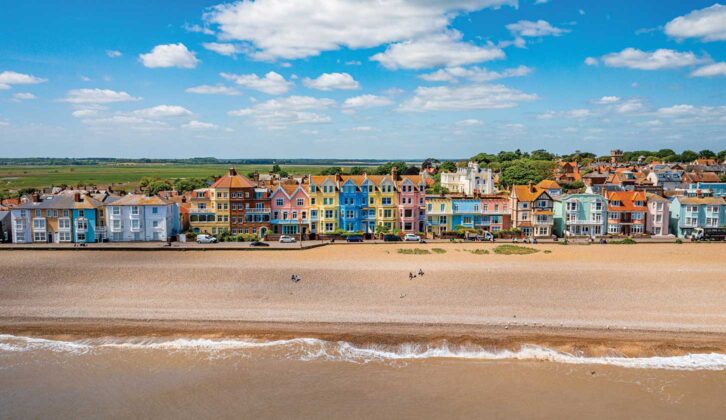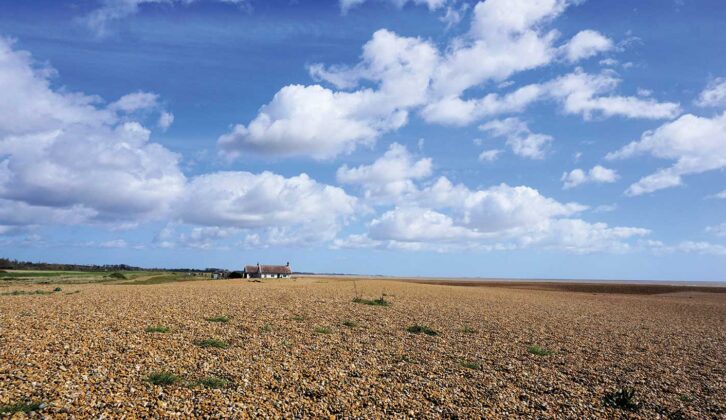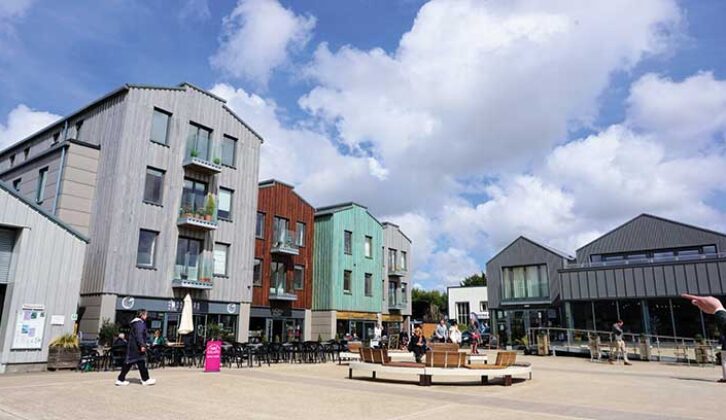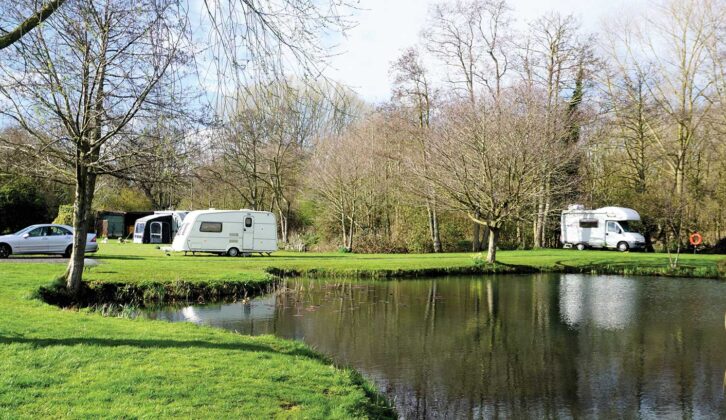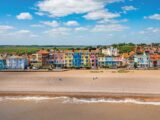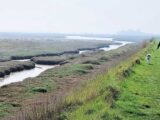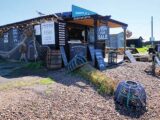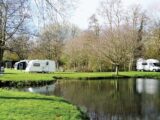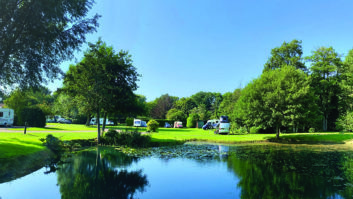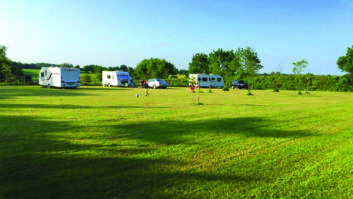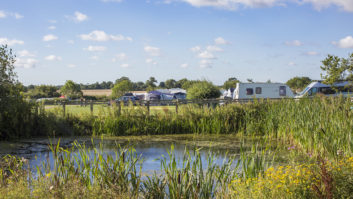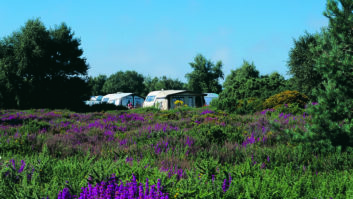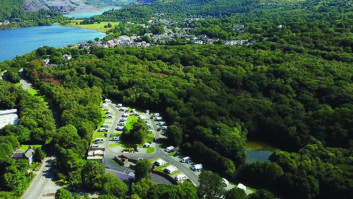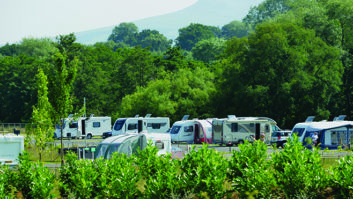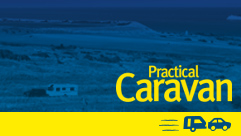When husband Ro suggested a trip “under the radar” to the Suffolk Coast & Heaths Area of Outstanding Natural Beauty, I didn’t realise he meant it almost literally, although I soon discovered my mistake.
This pretty region is dotted with villages and market towns, shingle beaches, river estuaries, woodlands and more. Plenty to interest inveterate explorers like us, while at the same time providing the kind of ‘get away from it all’ camping break we love.
Run Cottage Touring Park, in Hollesley, between the estuaries of the Rivers Deben and Alde, was to be our tranquil home from home. The best caravan parks offer the perfect starting point for some interesting and enjoyable days out, and that’s certainly the case with Run Cottage.
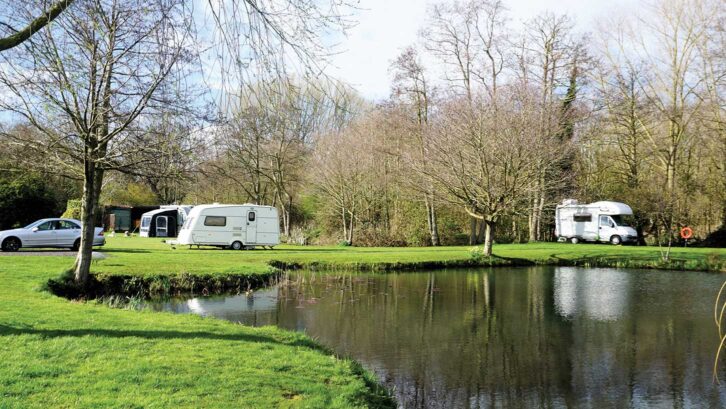
We had a great pitch on a site that actually featured in our guide to the best caravan parks in Eastern England, between the duck pond and the stream that borders the site, and soon made friends with the resident swan (which Ro naturally named Vesta).
We chose to explore the area by driving, but there are good public transport options should you prefer to leave your car on site. There are also a couple of ferries to get you across the estuaries if you fancy a boat trip.
Historic technology
So, back to being under the radar. We spent our first afternoon exploring the local area, and soon found ourselves at Bawdsey Radar Transmitter Block, a 10-minute drive from the site, which put us literally under the soaring column of the first fully operational radar station in the world.
After the inevitable jokes about not finding a signal, this proved an interesting museum, staffed by friendly, informative volunteers who were happy to explain its history, telling us some fascinating stories.
Bawdsey Manor House and outbuildings were acquired in 1936 for use as a research site, to develop the use of radar in detecting enemy aircraft. In 1939 the research facility was relocated and Bawdsey became a fully operational station. It remained in use throughout World War II and during the Cold War, finally closing in 1991.
Continuing our explorations, a few minutes further up the road is the small, but very pretty Bawdsey Quay. From here, you can catch a ferry across the Deben to Felixstowe. Today though, tired after our drive from home and with plenty of time ahead to explore further, we contented ourselves with a stroll on the sands before relaxing in the pleasant surroundings of our adults only caravan park for the evening.
Off to the beach
Next morning saw us heading for another beach – Shingle Street this time, at the mouth of the River Alde.
The most direct walking route takes you down some relatively quiet country lanes and will get you there in about 45 minutes, but we decided to take a longer trail, past Marsh Barn Farm Shop & Café, and the bird hide at RSPB Hollesley Marshes.
The café is attached to Hollesley Open Prison and run by staff and inmates as part of their rehabilitation programme. We were made welcome as we enjoyed bacon butties and a coffee before continuing our walk.
The small bird hide at RSPB Hollesley Marshes is about a half-hour stroll from the campsite and there are plenty of footpaths around the marshes to follow.
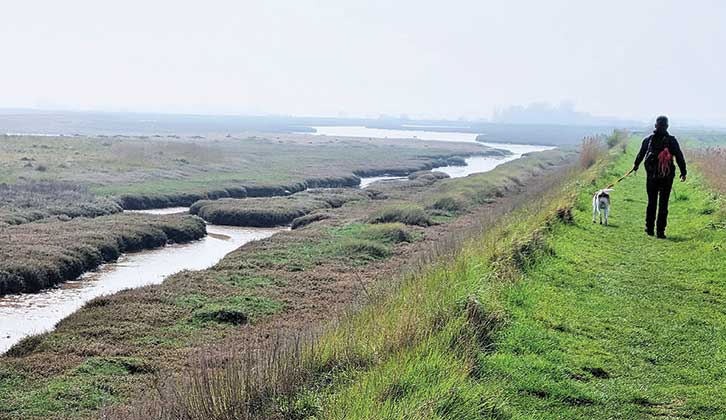
We, though, were off to Shingle Street, so returned to walk through the Open Prison (taking care not to stray from the public path) to continue on our way to the beach and the small hamlet lining the back of the shore.
Despite it being rather a windy day, we thoroughly enjoyed collecting shells and taking in the sea air on the almost hauntingly deserted stretch of shoreline. Then, having worked up a thirst on our two-hour walk, we called at The Shepherd & Dog in Hollesley village for a well-earned pint. Now it was just a 10-minute stroll to our pitch, where we could put our weary feet up and enjoy a home-cooked curry.
Ancient burial grounds
Next morning, we drove to Sutton Hoo, the National Trust property that is home to a royal Anglo-Saxon burial ground considered one of the most important archaeological finds ever made. Recently, its discovery was dramatised in the Netflix film The Dig. This tells the story of the self-taught amateur archaeologist Basil Brown, who in 1939, unearthed an Anglo-Saxon burial ship. Among its spectacular grave goods were golden weapons, armour, ornaments and the (now world-famous) Sutton Hoo helmet.
The occupants of the 18 burial mounds, which date back to the seventh century, remain unknown, but as we walked in the footsteps of those ancient people honouring their dead, we could see it must have been arduous to convey the heavy ship and other trappings to the site. Climbing the observation tower to view the area was quite enough for me!
There is also a museum and temporary exhibition detailing daily life – or our best guess about it – all those years ago.
Then it was time to stop for lunch in the dog-friendly café, before strolling around just some of the many acres surrounding the burial mounds. A quick detour to the secondhand bookshop and the gift shop, and we were heading towards home.
Back to the beach
Both Sutton Hoo and Shingle Street are close to the campsite, so we decided to revisit the beach before returning, to give Willow a little freedom to run around (dogs are allowed in most areas at Sutton Hoo, including the café, but must be kept under close control).
There is a small, free, car park on the edge of the dunes at Shingle Street, which happily was almost empty when we visited. This is one beach that has managed to keep itself under the tourist radar!
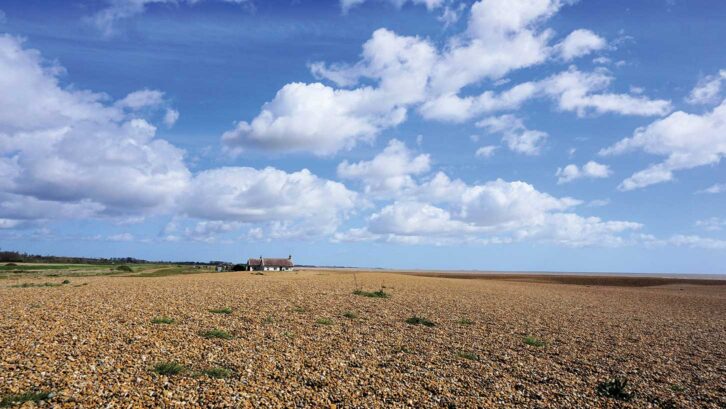
Parked up later at Run Cottage, we opted to return to The Shepherd & Dog to indulge in a pub dinner (if you wish to do the same, check the serving times, which vary from day to day), rounding off what had been a thoroughly enjoyable day out in Suffolk.
Day four saw us taking another short journey, this time to the market town of Woodbridge, which lies just beyond Sutton Hoo on the banks of the River Deben.
After a brief wander around this pretty town, we came across Tide Mill and its museum. This is one of only a handful of mills still producing flour on a commercial basis, something that it has been doing for more than 850 years now.
Next to Tide Mill, on the quayside, lies The Longshed, where a team of expert shipbuilders and craftspeople is building a replica of the 90ft Sutton Hoo burial ship, using, as far as possible, authentic tools and methods. It’s hugely impressive work and I can’t wait to return one day to see the finished article. Surrounding The Longshed is an excellent choice of eateries and we couldn’t resist popping into The Woodyard for a delicious pizza.
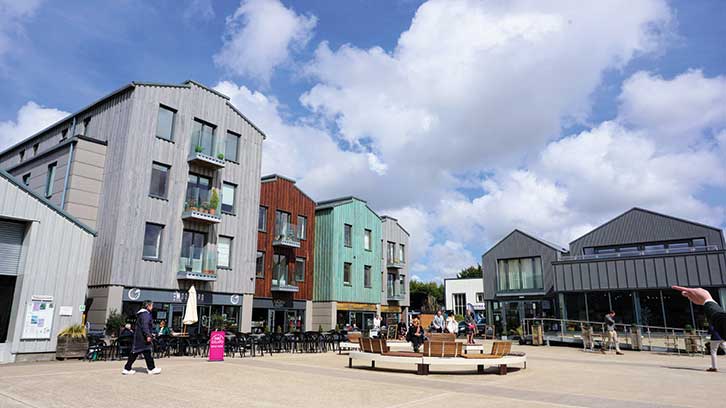
This is another dog-friendly venue, so Willow joined us (although much to her dismay, we didn’t allow her any pizza!). Later, our route back to the campsite took us through Rendlesham Forest and the Suffolk Coast & Heaths Area of Outstanding Natural Beauty.
We spied a couple of tempting footpaths and so decided to make the next day’s outing a walk in the forest. There are plenty of cycling trails, a children’s play area, picnic zones, and organised forest bathing events in Rendlesham.
Woodland walk
We were happy to stick to one of the many walking paths, which include an easy-access trail – and a UFO trail! This leads to an area of alleged UFO sightings during the winter of 1980, just outside RAF Woodbridge, at the time occupied by the United States Air Force. Little green men trying to slip in under their radar, perhaps?
This was a little too far from where we had parked for us to walk there that day (besides, I didn’t fancy being beamed up to a spaceship, even if we were close to military and radar installations), but we had an enjoyable, relaxing springtime forest walk in all that natural beauty.
Back on site, we couldn’t resist another visit to The Shepherd & Dog for dinner and a pint (we were on holiday…).
While there, we struck up a conversation with some locals, who let us into the ‘secret’ of the swathes of bowling green-quality grass that we passed on our drive out of Hollesley each day, while most of the fields belong to pig farms. Enterprising farmers, it seems, leave one or two of their fields pig-free each year and grow a specially formulated grass – which is then used to turf Wembley Stadium, no less!
The following day, our trip out took us 30 minutes along the coast, to Aldeburgh. On the way, we called in at Snape Maltings, the antiques and crafts centre lying in a very pretty setting on the Alde Estuary.
Sadly, we didn’t have time to venture along the Sailors’ Path, which follows the scenic route walked by sailors for hundreds of years between Snape and Aldeburgh.
Instead, we were keen to see the seaside at Aldeburgh – but there’s our reason to return sorted out again!
Our first sight after parking in the large car park beside the beach at Aldeburgh was the 4m-high steel scallop shell, designed by Suffolk-born artist Maggi Hambling and made by Aldeburgh craftsmen Sam and Dennis Pegg. It was installed in 2003 as a tribute to composer Benjamin Britten, who lived here for much of his life and founded the annual Aldeburgh Festival.
As we walked along the shore into town, we realised how fitting this sculpture is: the closer to Aldeburgh we strolled, the more shellfish cabins and fishing boats appeared.
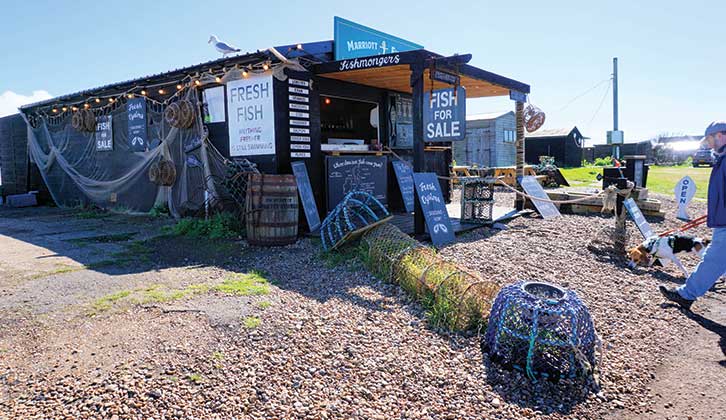
Seaside connections
This is definitely a town that owes its living to the sea, and much of its history. It was an important Tudor port and shipbuilding town. The Golden Hind, in which Francis Drake circumnavigated the world between 1577 and 1580, was just one of many great vessels built in the yards here.
Later, we enjoyed an excellent lunch of the freshest fish, eaten beside the sea.
The bench where we stopped for our meal turned out to be almost adjacent to the Moot Hall, a 16th-century building which now houses the town museum. With exhibits ranging from Anglo-Saxon finds to life at sea, this is an interesting archive of local history.
We then turned our attention to the gift shops and galleries and spent a happy hour or so window shopping.
There are plenty of opportunities to get out onto the water here, with busy sailing and yachting centres. You can also try your hand at horse riding – or llama trekking!
All too soon, it was time to head back for our final evening at Run Cottage, where the wind died down and the sun shone, allowing us to enjoy a barbecue while still feeling miles away from civilisation and contentedly reflecting on our time spent camping under the radar. Bliss.
If you’re after more ideas for where to go on your next tour, you can also see how I got on when I embarked on a tour to Caernarfon. You can also find out how Sue Greenwood got on when she explored Pateley Bridge, while Andria Massey found a tour to Hereford and Hay-on-Wye was an enjoyable getaway.
Planning a trip to Suffolk
Where we stayed in Suffolk
Run Cottage Touring Park
Address Alderton Road, Hollesley IP12 3RQ, 01394 411 309, runcottage.co.uk
- what3words: coherent.important.crouch
- Open: All year
- Pitches: 45
- Price From £31
This adults-only site in Hollesley is ideally located, close to the sea at Shingle Street and the market town of Woodbridge, in the beautiful scenery of the Suffolk Coast & Heaths Area of Outstanding Natural Beauty.
When to go to Suffolk
In June, the Aldeburgh Festival draws crowds of music-lovers to the area, but even in high summer, you can find remote beaches to explore.
Find out more
- Suffolk Coast & Heaths Area of Outstanding Natural Beauty
- Bawdsey Radar
- Shingle Street Beach
- Sutton Hoo
- Woodbridge Tide Mill
- Snape Maltings
- Aldeburgh
- Public transport – the nearest bus stop is about a 15-minute walk from Run Cottage
Lead image: Getty Images
If you’ve enjoyed reading this article, why not get the latest news, reviews and features delivered direct to your door or inbox every month. Take advantage of our brilliant Practical Caravan magazine SUBSCRIBERS’ OFFER and SIGN UP TO OUR NEWSLETTER for regular weekly updates on all things caravan related.
